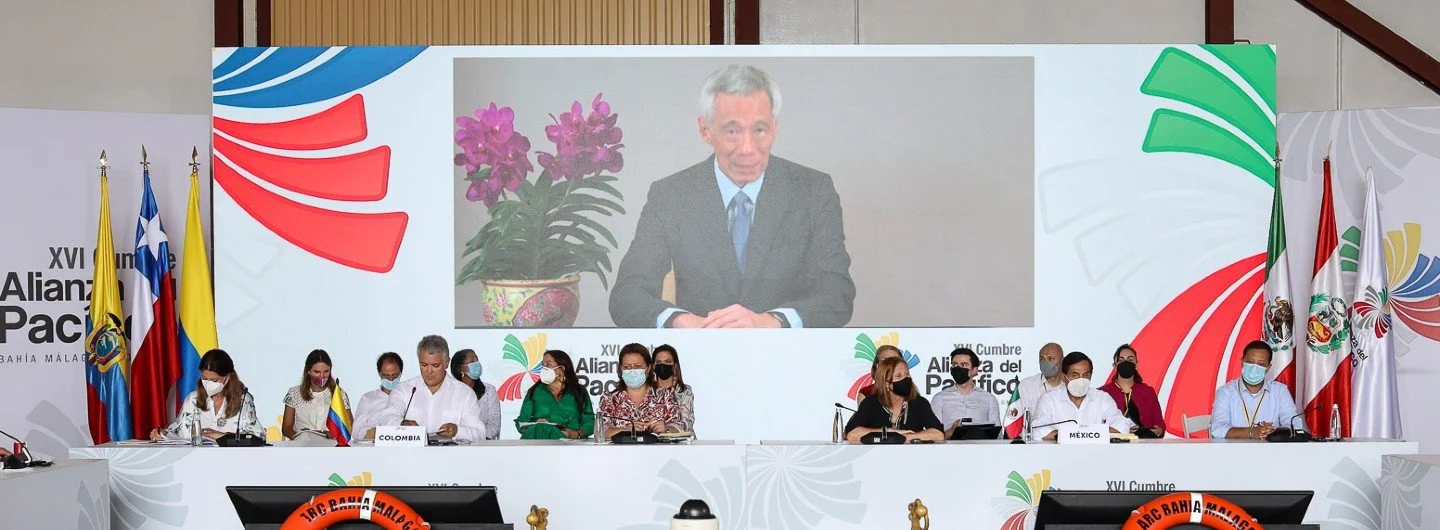On Jan 26, 2022 Singapore signed a Free Trade Agreement (FTA) with the Pacific Alliance (PA), a regional economic bloc made up of Chile, Colombia, Mexico and Peru representing more than USD 2 trillion in GDP. The Pacific Alliance Singapore FTA (PASFTA), has been touted as a “landmark moment” for Singapore’s partnership with Latin America with the potential to strengthen investment and market access opportunities for Singapore and PA countries. Despite the agreement’s potential, there remain economic, institutional and political factors that could affect the PA’s potential impact on Singapore and the region’s trade and investment opportunities. The PA has done a remarkable job in establishing itself as a platform with the potential to increase trade an investment between Latin American and the Asia-Pacific region. However, structural obstacles to intra-alliance trade, overlapping regional economic integration efforts and risks to institutional continuity will shape the size of the PA’s impact and influence in the region.
The Launch of RCEP
Apart from tariff benefits, RCEP members (and even non-members) can benefit from more streamlined customs procedures to facilitate trade. Building on existing ASEAN+1 agreements, RCEP introduces additional guidelines on the issue of advance rulings and on the release of goods at customs that improves certainty and reduces likelihood of shipment delays at the customs. The Chapter on Customs Procedures and Trade Facilitation also includes a scheme for authorised operators to benefit from reduced paperwork requirements, faster clearance of goods, and deferred payments or clearance at the premises of the authorized provider. While the assessment of benefits of FTAs are often fixated on tariff reductions for goods, it is equally important to recognize services and investment opportunities that RCEP offers to services providers and investors in Asia. RCEP provides further liberalization to services sectors such as legal services, accounting, architecture, computer services, wholesale trade and insurance, that can go well beyond existing ASEAN+1 agreements. This includes better market access, reduced limitations, and terms and conditions for the provision of services or the establishment of commercial presence in RCEP markets. For most service sectors, RCEP allows foreign service providers to deliver services across the border without requiring a local presence in the domestic market.
The CPTPP Expansion Challenge for America
This now puts the US in a particularly awkward position with Chinese entry to the CPTPP on the table. The easiest solution would be for the US to quickly come back to the revised deal. All the schedules have been maintained and could be reactivated. The 20 provisions that were “frozen” in the transition from TPP to CPTPP could be addressed. However, politically in the US, this is viewed as a “non-starter.” If the US were to return at this point, there would need to be additional adjustments made and, even then, it is not clear whether there might be sufficient votes in Congress to approve entry. The US, under the Biden Administration, continues to work on its trade policy dimensions. There is a review of policy with China, specifically, that has been underway for months. Until these are both clarified and supported by Congress, it’s not clear what sort of forward-looking offensive trade items might be possible. It could be something on digital or perhaps on climate. Since the US is neither likely to return to the CPTPP in the near term or have a comprehensive trade strategy in place, the US is in a pickle.
Time to Upgrade the CPTPP
Since all CPTPP member countries will gather together various working groups to discuss UK accession, it makes sense for these working parties to also reflect on what aspects of the agreement may need a bit of a refresh. There are lots of new ideas that have been built into other agreements that might be usefully imported in the CPTPP. One area, in particular, that is due for an upgrade is the e-commerce chapter. For example, it currently carves out in the opening chapter paragraphs, via the definitions of “covered persons,” the cross-border transfer of financial services data. This exception has not been replicated in other trade arrangements by the current CPTPP members. The existence of this definition is problematic because it seems to conflict with pledges elsewhere in the agreement, including the financial services chapter, to provide such services. It could be time to remove this exception or, at a minimum, relook at the language to determine whether it needs to remain exactly as it was originally written. The rest of the chapter was pathbreaking for its time. But the digital economy, in particular, does not stand still and many innovations in technology, the extent to which digital increasingly underpins nearly every other aspect of the economy, and changes in rules outside the CPTPP suggest that it is due for a closer look and review. Many members will balk or hesitate at the idea of adjusting the agreement now, and especially as part of an accession process. Thus far, every new member joining the deal has had to commit to taking the rule book “as it stands.” Bringing changes or a review into the accession proceedings sets a new precedent to allow future members to expect similar treatment. While a legitimate and valid concern, it raises the issue of when such reviews might take place. If not now, then when? Preparing teams to handle the CPTPP is not simple. Absent a Secretariat with full-time officials that have made CPTPP a daily priority, every government manages the CPTPP on the side or as part of their overall job addressing a range of trade commitments and new negotiations elsewhere. Staffing up at the level of detail and knowledge necessary to carefully review provisions is likely to be a major undertaking. It won’t happen again easily.
Using RCEP: High-Tech Electronics Manufacturing
The electronics industry is one where RCEP stands to make a meaningful impact. In most cases, trade in consumer electronics is already tariff-free thanks to the World Trade Organization’s Information Technology Agreement (ITA), enacted in 1996 and updated in 2015. The ITA and ITA2 has provided duty or tariff-free access to a wide range of listed electronics products. It has helped underpin today’s digital economy as the agreement lowered costs for everything from laptops to mobile devices. While the agreements dropped tariffs on (mostly) final products, the inputs for these goods received fewer benefits. Many tariffs remain in place, adding a substantial burden to the countries and companies that manufacture high-tech consumer electronics. Though pre-existing agreements like the ITA have already eliminated most tariffs on final consumer goods, RCEP still stands to benefit the consumer electronics industry in the region. While consumer electronics are often assembled for the final consumer in factories in China, individual components might come from places like South Korea, Japan and ASEAN. Components themselves may be largely tariff-free, but this is not necessarily true of the hugely expensive inputs necessary for their production. An example can be found in flat display screen manufacturing equipment. Many of the world’s liquid crystal display (LCD) and next-gen organic light emitting diode (OLED) devices are manufactured in East Asian cleanrooms. LCD and OLED devices are semiconductor technologies used in modern display screens everywhere from laptops to smartwatches to fridges.





